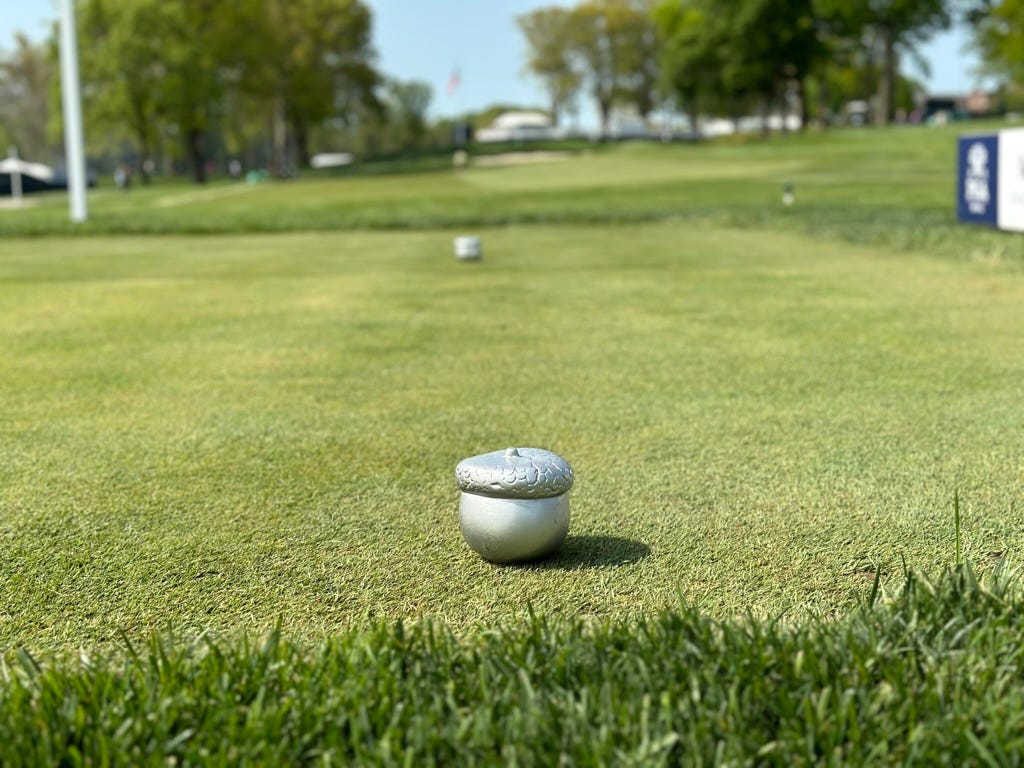Destination Unknown
Major venues faced uncertainty and mystery in 2023. A review of the setups through the eyes of those who prepared the courses. Plus, a poll!
Only the Christmas spirit packs up faster than a major championship. So I’ll plead guilty as charged here for not unpacking more about what went into the big weeks after so many months of build-up. But with a condensed major schedule and 2023’s general fatigue over the “plight” of pro golf, I think we all needed a vacation from the dweebery. At least, that’s my working excuse for bypassing year-in-review coverage.
The mysteriousness surrounding 2023’s biggest stages provided intrigue and sleepless nights for those charged with finding that delicate balance of difficulty, intrigue and function. Only F1 course designers are faced with greater coures setup challenges given the variety of settings, speeds reached and assorted problems that arrive with the smallest boondoggle (that life-or-death stuff).
Like the acoustician who never knows how a room will sound until it’s filled with people, gear and adrenaline-infused performances, major championship course setup is a delicate high-wire act. Between weather, green speeds, turf health, player griping, host course egos and modern driving distances, so much can go wrong. But unlike the sound experts who can suggest adjustments to engineers at the board, a course setup team can only flick so many switches after the gun goes off.
The big unknowns going into 2023:
After years of speculation and scrutiny, Augusta National unveiled a new 13th tee on one of the most iconic holes in tournament golf.
The renamed Chevron Championship, a.k.a. The Dinah, moved to an untested Texas course after a half-century in Rancho Mirage.
A boldly restored Oak Hill would play nothing like it did the first six majors the East hosted and this time around arrived in springtime with unpredictable growing conditions.
Los Angeles Country Club had never hosted a full-field championship, much less a U.S. Open in June when morning marine layers and high afternoon sun make West Coast majors trickier to present than they look.
Like Oak Hill, time-tested Baltusrol unveiled a significantly refreshed design for the KPMG Women’s PGA.
Pebble Beach welcomed the world’s best women for the first time and at a time of year where weather can flip from dank fog to bright sun and high winds (which happened).
The Open returned to venerable Hoylake with its new and diabolical par 3 17th along with other changes on a course where wind direction and velocity impacts play differently than at a traditional out-and-back links.
The Women’s Open turned up at Walton Heath for the first time and hosted a field light on heathland golf experience.
The Old Course witnessed its first pure match play event since the last time it hosted the Walker Cup in 1975.
The completely rebuilt Marco Simone hosted stroke play events in the spring, but could it embellish the early fall match play that it was redesigned for?
Despite weather issues and surprising winners, each of the aforementioned venues delivered varying degrees of success. So I thought it’d be nice to circle back with the folks who were charged with envisioning how the courses would play. Emphasis on the big four because, well, this is The Quadrilateral.
The Masters
Winner: Jon Rahm
Players started the week making end times declarations about the new 13th tee installed at massive expense and in expanding some of the best acreage in all of sports. Stretched to 545-yards, even the longest drivers in the field predicted lay-ups galore despite their athletic abilities supposedly fueling huge distance gains.
And it all worked out fine.
The venerable par 5 saw some of the risk returned. After all those millions, Azalea played about as it had for decades before all the decathletes gave up tanks and shorts for cashmere hoodies and Fred Astaire bucks.
With normal Augusta springtime weather for Thursday’s first round, more than half the field went for the green. (This, in a limited field tournament with older past champions who are just happy to carry Rae’s Creek off the tee…oh you know I kid the past champions.)
The final numbers:
The extended hole averaged 4.736 to rank 15th for the week. The 13th gave up 8 eagles, 108 birdies, 122 pars, 30 bogeys, 7 doubles and 2 others.
In 2022 when Azalea measured 35 yards shorter, it produced 6 eagles, 91 birdies, 139 pars, 37 bogeys, 6 doubles and 4 others.
The cumulative scoring average coming into 2023 was 4.775.
As for the big decision to go for it? It’s back. But did they make it long enough?
PGA Championship and Women’s PGA
Winners: Brooks Koepka and Ruoning Yin
Champions, Cutmakers and (Point) Missers, KPMG Women’s PGA wrap up.
As with Southern Hills in 2022, the PGA’s longtime setup man Kerry Haigh returned to revitalized versions of Oak Hill and Baltusrol looking nothing like they did during previous majors.
“Both courses are steeped in history yet both have recently undergone fairly major restorations which, in our opinion, helped make them better tests of golf,” Haigh said, labeling architect Andrew Green’s restoration and superintendent Jeff Corcoran’s work “fabulous.”
The Donald Ross-designed Oak Hill East had become a dreary place for a tournament: overgrown by trees, suffocated by rough and featuring shrunken greens that made the entire thing one-dimensional, only made worse a couple of modern replacement holes thrown in.
“The expansion of the greens and, in particular, the tongues on the corners of many of the greens really did make a significant difference to the hole location options,” said Haigh, who cited the new options at the first, fourth, seventh, 10th, 13th, and 18th as adding new dimensions, while the completely new 6th and 15th stood out to Haigh as standout improvements.
The sixth played as a par 4 to what felt more like a par 5 green and ended the week as Oak Hill’s toughest hole.
The 15th was returned to an unusual short one-shotter surrounded by sand and steep, tightly mown area to the right.
“The new [sixth] green is one of the most challenging on the golf course and with the wind mostly into the players, the hole played tough but fair and required two good shots to get into position for a birdie or par all week,” he said.
Haigh also highlighted the stunning transformation of the short par 4 14th hole thanks to “more hole locations, a better look from the tee and the trees removed from behind the green.” It was the standout change visually, in terms of tournament intrigue and in capturing the beauty of Donald Ross green contours. But the 14th lacked buzz since so few fans could get near the raised green abutted by a steep falloff behind.
More debatable in terms of success and sympathy to the style of Ross were low cut run-off areas that felt right in some spots while seeming forced in a few others. Haigh felt they were a success by providing shot options around the greens. He even liked the 15th which, because of a steep upslope, left little room for anything but a flop shot.
“The run off to the right of 15 was and is one of the more interesting run offs that we have encountered with the steepness of the bank off the green being a higher cut and the angle of approach required to some of the hole locations.”
Haigh said the greatest test faced all week came with the bleak Saturday forecast featuring all-day rain. Thanks to new new bells and whistles under the hood installed to help Oak Hill drain better, superintendent Corcoran assured him the course could handle it.
“He was confident that we would be able to play all day,” Haigh says. “After the first hour of rain we started puddling and had to send out squeegies, but as Jeff predicted, once the water got thru the top surface it would be able to take more rain. It rained for the next 8 hours and we were able to play on and complete the round.”
Haigh it was an easy call for shot of the week: Michael Block’s hole-in-one Sunday at the new 15th.
At Baltusrol a month later, Haigh raved about the Lower Course restoration by Gil Hanse and Jim Wagner and the maintenance crew effort overseen by Greg Boring. With restored and re-positioned bunkering, Haigh said the outcome was “perfect” in returning relevancy to the tee shot landing areas for the world’s best women.
Haigh has admirably refused to discuss Stimpmeter speeds in hopes of setting a positive example, but singled out Baltusrol’s old school green surfaces.
“The poa annua greens are still amazing when managed by one of the best in the business,” he says while citing green expansion as greatly improving the front right of the famous par-3 4th, the back right of Nos. 8 and 9, the front right and front left of No. 10, “anywhere” on hole 11, the middle right on No. 13, the back right on No. 15 and the front right of No. 17.
Haigh said the restoration of the penultimate hole’s famous Sahara cross bunker prior to the KPMG Women’s PGA caused “challenges due to the hole playing into the wind on many days,” but he also said the more amenable par-5 18th “proved to be an extremely exciting finishing hole” when major championship pressure saw “a number of contenders hit their tee shots into the water which hurt their chances of winning.”
Baltusrol next hosts the 2029 PGA Championship and Haigh has an early scouting tip for players: “the green on the second hole is one of the most challenging that we ever play.”
U.S. Open and U.S. Women’s Open
Winner: Wyndham Clark and Allisen Corpuz
Champions, Cutmakers and Point-missers (U.S. Open) and Tournament roundup (U.S. Women’s Open)
While I won’t bore with all I saw and hoped for with Los Angeles Country Club’s first U.S. Open, the preview series of our restoration should give you an idea of how curious I was to see how the North would fare. In the months since I’ve heard from plenty who felt the week was sullied by a combination of record low first day scoring, absence of consistent hack-out rough guarding narrow fairways, excessively long par 3’s and low fan energy caused by an emphasis on corporate and member ticket sales.









